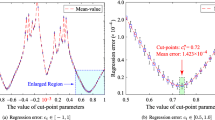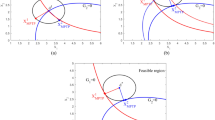Abstract
This paper presents an adaptive-sparse polynomial chaos expansion (adaptive-sparse PCE) method for performing engineering reliability analysis and design. The proposed method combines three ideas: (i) an adaptive-sparse scheme to build sparse PCE with the minimum number of bivariate basis functions, (ii) a new projection method using dimension reduction techniques to effectively compute the expansion coefficients of system responses, and (iii) an integration of copula to handle nonlinear correlation of input random variables. The proposed method thus has three positive features for reliability analysis and design: (a) there is no need for response sensitivity analysis, (b) it is highly efficient and accurate for reliability analysis and its sensitivity analysis, and (c) it is capable of handling a nonlinear correlation. In addition to the features, an error decomposition scheme for the proposed method is presented to help analyze error sources in probability analysis. Several engineering problems are used to demonstrate the three positive features of the adaptive-sparse PCE method.













Similar content being viewed by others
References
Au SK, Beck JL (2001) Estimation of small failure probabilities in high dimensions by subset simulation. Probab Eng Mech 16(4):263−277
Bieri M, Schwab C (2009) Sparse high order FEM for elliptic sPDEs. Comput Methods Appl Mech Eng 198:1149−1170
Blatman G, Sudret B (2008) Sparse polynomial chaos expansions and adaptive stochastic finite elements using a regression approach. Comptes Rendus Mécanique 336(6):518−523
Breitung K (1984) Asymptotic approximations for multinormal integrals. J Eng Mech Div ASCE 110(3):357−366
Cameron RH, Martin WT (1947) The orthogonal development of nonlinear functionals in series of Fourier−Hermite functionals. Ann Math 48:385−392
Choi S, Grandhi RV, Canfield RA (2004a) Structural reliability under non-Gaussian stochastic behavior. Comput Struct 82:1113−1121
Choi S, Grandhi RV, Canfield RA, Pettit CL (2004b) Polynomial chaos expansion with latin hypercube sampling for estimating response variability. AIAA J 42(n6):1191−1198
Creveling CM (1997) Tolerance design: a handbook for developing optimal specification. Addison-Wesley, Cambridge
Field RV (2002) Numerical methods to estimate the coefficients of the polynomial chaos expansion. In: Proceedings of the 15th ASCE engineering mechanics conference
Foo J, Karniadakis GE (2010) Multi-element probabilistic collocation method in high dimensions. J Comput Phys 229:1536−1557
Foo J, Wan X, Karniadakis GE (2008) The multi-element probabilistic collocation method (ME-PCM): error analysis and applications. J Comput Phys 227:9572−9595
Franke R (1979) A critical comparison of some methods for interpolation of scattered data. Naval Postgraduate School Technical Report, NPS-53-79-003
Fu G, Moses F (1988) Importance sampling in structural system reliability. In: Proceedings of ASCE joint specialty conference on probabilistics method. Blacksburg, Virginia, United States, pp 340−343
Gerstner T, Griebel M (1998) Numerical integration using sparse grids. Numer Algorithms 18(3):209−232
Gerstner T, Griebel M (2003) Dimension-adaptive tensor-product quadrature. Computing 71(1):65−87
Ghanem RG, Spanos PD (1991) Stochastic finite elements: a spectral approach. Springer, New York
Han J, Kamber M (2000) Data mining: concepts and techniques (the Morgan Kaufmann Series in data management systems). Morgan Kaufmann
Hasofer AM, Lind NC (1974) Exact and invariant second-moment code format. J Eng Mech Div ASCE 100:111−121
Kohavi R (1995) A study of cross-validation and bootstrap for accuracy estimation and model selection. In: Proceedings of the international joint conference on artificial intelligence—IJCAI’95’
Le Maître OP, Knio OM, Najm HN, Ghanem RG (2001) A stochastic projection method for fluid flow—I. Basic formulation. J Comput Phys 173:481−511
Le Maître OP, Reagan M, Najm HN, Ghanem RG, Knio OM (2002) A stochastic projection method for fluid flow–II. Random process. J Comput Phys 181:9−44
Le Maitre O, Najm H, Ghanem R, Knio O (2004) Multi-resolution analysis of Wiener-type uncertainty propagation schemes. J Comput Phys 197:502−531
Lee SH, Chen W (2007) A comparative study of uncertainty propagation methods for black-box-type problems. Struct Multidiscipl Optim. doi:10.1007/s00158-008-0234-7
Lee SH, Kwak BM (2005) Response surface augmented moment method for efficient reliability analysis. Struct Saf 28:261−272
Lee I, Choi KK, Du L, Gorsich D (2008) Dimension reduction method for reliability-based robust design optimization. Comput Struct 86(13-14):1550−1562
Liu H, Chen W, Kokkolaras M, Papalambros PY, Kim HM (2006) Probabilistic analytical target cascading: a moment matching formulation for multilevel optimization under uncertainty. J Mech Des 128(4):991−1000
Ma X, Zabaras N (2009) An adaptive hierarchical sparse grid collocation algorithm for the solution of stochastic differential equations. J Comput Phys 228:3084−3113
Noh Y, Choi KK, Du L (2008) Selection of copula to generate input joint CDF for RBDO. In: ASME international design engineering technical conference & computers and information in engineering conference, IDETC2008-49494, Brooklyn, New York, United States, 3−6 August 2008
Noh Y, Choi KK, Du L (2009) Reliability-based design optimization of problems with correlated input variables using a Gaussian Copula. Struct Multidiscipl Optim 38(1):1−16
Paffrath M, Wever U (2007) Adapted polynomial chaos expansion for failure detection. J Comput Phys 226:263−281
Penmetsa R, Grandhi R (2003) Adaptation of fast Fourier transformations to estimate structural failure probability. Finite Elem Anal Des 39:473−485
Rahman S (2006) A dimensional decomposition method for stochastic fracture mechanics. Eng Fract Mech 73(15):2093−2109
Rahman S (2009) Stochastic sensitivity analysis by dimensional decomposition and score functions. Probab Eng Mech 24(3): 278−287
Rahman S, Xu H (2004) A univariate dimension-reduction method for multi-dimensional integration in stochastic mechanics. Probab Eng Mech 19:393−408
Rosenblatt M (1952) Remarks on a multivariate transformation. Ann Math Stat 23:470−472
Roser BN (1999) An introduction to copulas. Springer, New York
Rubinstein RY (1981) Simulation and the Monte Carlo method. Wiley, New York
Smolyak SA (1963) Quadrature and interpolation formulas for tensor products of certain classes of functions. Sov Math Dokl 4:240−243
Sudret B, Der Kiureghian A (2002) Comparison of finite element reliability methods. Probab Eng Mech 17:337−348
Todor RA, Schwab C (2007) Convergence rates for sparse chaos approximations of elliptic problems with stochastic coefficients. IMA J Numer Anal 27:232−261
Tvedt L (1984) Two second-order approximations to the failure probability. Section on structural reliability. A/S Vertas Research, Hovik
Wan X, Karniadakis GE (2005) An adaptive multi-element generalized polynomial chaos method for stochastic differential equations. J Comput Phys 209(2):617−642
Wan X, Karniadakis GE (2006) Multi-element generalized polynomial chaos for arbitrary probability measures. SIAM J Sci Comput 28:901−928
Wang LP, Grandhi RV (1996) Safety index calculation using intervening variables for structural reliability. Comput Struct 59(6):1139−1148
Wiener N (1938) The homogeneous chaos. Am J Math 60:897−936
Wu CC, Chen Z, Tang GR (1998) Component tolerance design for minimum quality loss and manufacturing cost. Comput Ind 35:223−232
Xiu D (2009) Fast numerical methods for stochastic computations: a review. Communications in Computational Physics 5:242− 272
Xiu D, Karniadakis GE (2003) The Wiener-Askey polynomial chaos for stochastic differential equations. SIAM J Sci Comput 187:137−167
Xu H, Rahman S (2004) A generalized dimension-reduction method for multi-dimensional integration in stochastic mechanics. Int J Numer Methods Eng 61:1992−2019
Youn BD, Choi KK (2004a) An investigation of nonlinearity of reliability-based design optimization approaches. J Mech Des 126(3):403−411
Youn BD, Choi KK (2004b) A new response surface methodology for reliability based design optimization. Comput Struct 82:241−256
Youn BD, Choi KK, Gu L, Yang RJ (2004) Reliability-based design optimization for crashworthiness of side impact. J Struct Multidiscipl Optim 26(3-4):272−283
Youn BD, Zhimin X, Wang P (2007a) Eigenvector dimension reduction (EDR) method for sensitivity-free probability analysis. Struct Multidiscipl Optim 37:13−28
Youn BD, Zhimin X, Wang P (2007b) Reliability-based robust design optimization using the eigenvector dimension reduction (EDR) method. Struct Multidiscipl Optim 37:475−492
Zhao YG, Ono T (2001) Moment methods for structural reliability. Struct Saf 23(1):47−75
Acknowledgments
The authors would like to acknowledge that this research is partially supported by US National Science Foundation (NSF) under Grant No. GOALI-0729424, U.S. Army TARDEC by the STAS contract (TCN-05122), and by General Motors under Grant No. TCS02723.
Author information
Authors and Affiliations
Corresponding author
Appendix
Appendix
The derivation of the error decomposition
-
Error source I:
Truncation
$$\begin{array}{rll} \varepsilon _P^2 &=&\int_\Gamma \big[{g-\emph{w}_{UB}^p} \big]^2f({\rm {\bf x}})d{\rm {\bf x}} \\[12pt] &=&\int_\Gamma {\left[ {\begin{array}{@{}l} \displaystyle \sum\limits_k {\sum\limits_{j>p} {s_j^k \cdot \Phi _j ({\zeta _k})} } \\[18pt] + \displaystyle\sum\limits_{[x_k ,x_l ]\notin {\rm {\bf B}}} \sum\limits_{j_1 +j_2 \le p} s_{j_1 ,j_2 }^{k,l} \cdot \Phi _{j_1 ,j_2}({\zeta _k ,\zeta _l}) \\[18pt] + \displaystyle\sum\limits_{k<l} \sum\limits_{j_1 +j_2 >p} s_{j_1 ,j_2}^{k,l} \cdot \Phi _{j_1 ,j_2 } ({\zeta _k ,\zeta _l}) \\[18pt] \displaystyle +\sum\limits_{k<l<m} \sum\limits_{j_1 ,j_2 ,j_3 \ge 1} s_{j_1 ,j_2 ,j_3 }^{k,l,m} \\[18pt] \cdot \Phi _{j_1 ,j_2 ,j_3 } \left( {\zeta _k ,\zeta _l ,\zeta _m } \right) +\cdots \\ \end{array}}\!\!\! \right]^2 \!\! f({\rm {\bf x}})d{\rm {\bf x}}} \end{array}$$ -
Error source II:
Bivariate decomposition
$$\begin{array}{rll} \varepsilon _B^2 &=&\int_\Gamma {\big[ {\emph{w}_{UB}^p -\emph{w}_U^p} \big]^2f({\rm {\bf x}})d{\rm {\bf x}}} \\[-1.5pt] &=&\int_\Gamma {\left[ {\sum\limits_{[{x_k ,x_l}]\in {\rm {\bf B}}} {\sum\limits_{j_1 +j_2 \le p} {\big( {s_{j_1 ,j_2 }^{k,l} -\hat {s}_{j_1 ,j_2 }^{k,l}} \big)\Phi _{j_1 ,j_2 } ({\zeta _k ,\zeta _l})} } } \right]^2f({\rm {\bf x}})d{\rm {\bf x}}} \\[-1.5pt] &=&\int_\Gamma {\left[ {\sum\limits_{[{x_k ,x_l}]\in {\rm {\bf B}}} {\sum\limits_{j_1 +j_2 \le p} {\frac{E\left[ {\big( {g({\rm {\bf x}})-g\big( {x_k ,x_l ,\boldsymbol{\upmu}^{k,l}} \big)} \big)\cdot \Phi _{j_1 ,j_2} ({\zeta _k ,\zeta _l})} \right]}{E\big[ {\Phi _{j_1 ,j_2 }^2 ({\zeta _k ,\zeta _l})} \big]}} } \cdot \Phi _{j_1 ,j_2 } ({\zeta _k ,\zeta _l})} \right]^2f ({\rm {\bf x}})d{\rm {\bf x}}} \end{array}$$where
$$\begin{array}{rll} && E\left[ {\left( {g({\rm {\bf x}})-g\left( {x_k ,x_l ,\boldsymbol{\upmu}^{k,l}} \right)} \right)\Phi _{j_1 ,j_2} ({\zeta _k ,\zeta _l})} \right] \\[-1.5pt] &&{\kern10pt} =\frac{1}{2!1!1!}\sum\limits_{i\ne k,l} {\frac{\partial ^4g}{\partial x_i^2 \partial x_k \partial x_l }(\boldsymbol{\upmu})} \cdot E\big[{({x_i -\mu _i})^2({x_k -\mu _k})({x_l -\mu _l})\Phi _{j_1 ,j_2 } ({\zeta _k ,\zeta _l })} \big]+\cdots \end{array}$$ -
Error source III:
Univariate decomposition
$$\begin{array}{rll} \varepsilon _U^2 &=& \int_\Gamma {\big[ {\emph{w}_U^p -\emph{w}_I^p } \big]^2f( {\rm {\bf x}} )d{\rm {\bf x}}} = \int_\Gamma {\left[ {\sum\limits_{k=1}^N {\sum\limits_{j=1}^p {\left( {s_j^k -\hat {s}_j^k } \right)\Phi _j \left( {\zeta _k } \right)} } } \right]^2f\left( {\rm {\bf x}} \right)d{\rm {\bf x}}} \\ &=&\int_\Gamma {\left[ {\sum\limits_{k=1}^N {\sum\limits_{j=1}^p {\frac{E\left[ {\left( {g\left( {\rm {\bf x}} \right)-g\left( {x_k ,\boldsymbol{\upmu}^k} \right)} \right)\Phi _j \left( {\zeta _k } \right)} \right]}{E\big[ {\Phi _j^2 ({\zeta _k})}\big]}} } \cdot \Phi _j ({\zeta _k})} \right]^2f({\rm {\bf x}})d{\rm {\bf x}}} \end{array}$$where
$$ E\left[ {({g({\rm {\bf x}})-g ({x_k ,\boldsymbol{\upmu}^k})})\Phi _j ({\zeta _k})} \right] = \frac{1}{2!1!}\sum\limits_{i\ne k} {\frac{\partial ^3g}{\partial x_i^2 \partial x_k }(\boldsymbol{\upmu})} E\big[ {( {x_i -\mu _i } )^2({x_k -\mu _k})\Phi _j ({\zeta _k})} \big]+\cdots $$ -
Error source IV:
Aliasing error
$$\begin{array}{rll} \varepsilon _I^2 &=&\int_\Gamma {\big[ {\emph{w}_I^p -\emph{w}^p} \big]^2} f({\rm {\bf x}})d{\rm {\bf x}} \\[-1.5pt] &=&\int_\Gamma {\left[ {\sum\limits_{k=1}^N {\sum\limits_{j=1}^p {\left( {\hat {s}_j^k -\hat {\hat {s}}_j^k } \right)\Phi _j ({\zeta _k}) +\sum\limits_{[{x_k ,x_l}]\in {\rm {\bf B}}} {\sum\limits_{j_1 +j_2 \le p} {\left( {\hat {s}_{j_1 ,j_2 }^{k,l} -\hat {\hat {s}}_{j_1 ,j_2 }^{k,l}}\right)\Phi _{j_1 ,j_2} ({\zeta _k ,\zeta _l})}}}}} \right]^2f ({\rm {\bf x}})d{\rm {\bf x}}} \\[-1.5pt] &=&\int_\Gamma {\left[ {\begin{array}{l} \displaystyle \sum\limits_{k=1}^N {\sum\limits_{j=1}^p {\frac{\big({E-\hat {E}} \big)\left[ {g\big({x_k ,\boldsymbol{\upmu}^k}\big)\Phi _j ({\zeta _k})} \right]}{E\big[ {\Phi _j^2 \left( {\zeta _k } \right)} \big]}} } \cdot \Phi _j ({\zeta _k}) \\ \displaystyle{\kern12pt} +\sum\limits_{[{x_k ,x_l}]\in {\rm {\bf B}}} {\sum\limits_{j_1 +j_2 \le p} {\frac{\big({E-\hat {E}}\big)\left[ {g( {x_k ,x_l ,\boldsymbol{\upmu}^{k,l}})\cdot \Phi _{j_1 ,j_2 } ({\zeta _k ,\zeta _l})} \right]}{E\big[ {\Phi _{j_1 ,j_2 }^2 ({\zeta _k ,\zeta _l})} \big]}} } \cdot \Phi _{j_1 ,j_2 } ({\zeta _k ,\zeta _l }) \\ \end{array}} \right]^2f ({\rm {\bf x}})d{\rm {\bf x}}} \end{array}$$where \(\hat {E}(\cdot)\) denotes the approximate expectation by using the SMLS and Gaussian quadrature integration.
Rights and permissions
About this article
Cite this article
Hu, C., Youn, B.D. Adaptive-sparse polynomial chaos expansion for reliability analysis and design of complex engineering systems. Struct Multidisc Optim 43, 419–442 (2011). https://doi.org/10.1007/s00158-010-0568-9
Received:
Revised:
Accepted:
Published:
Issue Date:
DOI: https://doi.org/10.1007/s00158-010-0568-9




